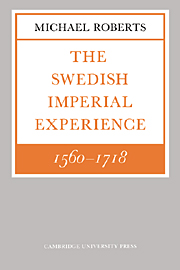II - Resources, material and moral
Published online by Cambridge University Press: 06 January 2010
Summary
such, then, was the imperial superstructure which necessity or ambition, economic design or political calculation, imposed upon the Swedish realm.
How far was that realm qualified to sustain the burdens and responsibilities laid upon it? What natural advantages, what special aptitudes had it at its command, to fit it for its imperial destiny?
At first sight, one would be tempted to pronounce those advantages few and insufficient. Sweden was, and until the nineteenth century would remain, a poor country: sparsely populated; underdeveloped; the victim of a rigorous climate. In Gustav Adolf's reign Sweden and Finland together had a population of perhaps a million and a quarter. That population did indeed increase throughout the century; but the annual rate of growth was very slow: somewhere between 2.2 and 2.7 per thousand. Perhaps the land could hardly feed many more: men were well content with an average harvest yield of fourfold, or sixfold on the best land; between 1523 and 1781 only one year in eight could be reckoned a good one: in the northern half of the country the eating of bark-bread was almost a normal resource, and the cows were dry for nine months of the year. Domestic production of grain was barely sufficient in ordinary times, and in a few years left a surplus for export. The Brandenburg statesman Count Waldeck once declared ‘The Swedes are a hungry people, and hence they are dangerous and hard-hearted’
- Type
- Chapter
- Information
- The Swedish Imperial Experience 1560–1718 , pp. 43 - 82Publisher: Cambridge University PressPrint publication year: 1979



